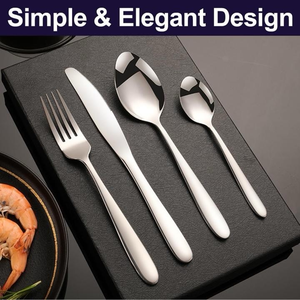Search
1/9
£7.99 - 17.99
24 Pcs Multicoloured durable tableware sets - Stainless Steel Cutlery Dinner Set for party, Christmas Mirror Finish, Reusable Utensils Knife spoon folk tea spoon in Gold Rainbow Silver Black Metal
Sold by Lavish Home
4(10)
127 sold
Select options
Select
Shipping
£3.48
Specifications
Customer reviews (10)
h**4
Item: Rainbow, 24 Pcs (6 Spoon,6 Folks,6 Table Knife,6 Tea Spoon)
Amazing quality and the colours really pop against my place settings on my dining table
4 February 2025

H**i D**s
Item: Gold, 24 Pcs (6 Spoon,6 Folks,6 Table Knife,6 Tea Spoon)
After a week they have Gone silver as all of the brass has worn off

8 January 2025

n**a l**n
Item: Gold, 16 Pcs (4 Spoon,4 Folk, 4 Table Knife,4 Tea Spoon)
14 January 2025

ر**و ب**🇧
Item: Gold, 16 Pcs (4 Spoon,4 Folk, 4 Table Knife,4 Tea Spoon)
Color change from first use
3 wk ago

B**
Item: Gold, 24 Pcs (6 Spoon,6 Folks,6 Table Knife,6 Tea Spoon)
Good stainless products
21 December 2024

s**a
Item: Gold, 16 Pcs (4 Spoon,4 Folk, 4 Table Knife,4 Tea Spoon)
3 wk ago

j**l
Item: Gold, 24 Pcs (6 Spoon,6 Folks,6 Table Knife,6 Tea Spoon)
22 December 2024

M**0
Item: Rainbow, 16 Pcs (4 Spoon,4 Folk, 4 Table Knife,4 Tea Spoon)
21 December 2024

J**n
Item: Gold, 16 Pcs (4 Spoon,4 Folk, 4 Table Knife,4 Tea Spoon)
18 December 2024

K**a
Item: Gold, 24 Pcs (6 Spoon,6 Folks,6 Table Knife,6 Tea Spoon)
14 December 2024
For more info on customer reviews, read ourTikTok Shop UK/EU Customer Review Policy.

Lavish Home
11 items
Shop performance
Better than 74% of other shops
4+ star rating
76%
Ships within 2 days
67%
About this product
- Brand:LAVISHLY
- Feature:Durable,Dishwasher Safe,Reusable,Stainless steel,Thick
- Age:Adult
- Quantity Per Pack:16
- Material:Stainless Steel
Product description
Stainless Steel Cutlery Set in GOLD, BLACK, RAINBOW, SILVER
Stainless steel cutlery is a type of flatware or utensils made from stainless steel, a versatile and highly durable metal alloy. It is a popular choice for everyday and formal dining due to its numerous advantages. There's a Detailed description of stainless steel cutlery Below:
Colors:
•Gold, Rainbow, Black, Silver
16pcs Cutlery Set:
•4 x knives, 4 x forks, 4 x table spoons and 4 x tea spoons. (serves for 4 people)
24pcs Cutlery Set:
•6 x knives, 6 x forks, 6 x tablespoons and 6 x tea spoons. (serves for 6 people)

(16 Pcs Cutlery & 4 Straws Set)
•4 x knives, 4 x forks, 4 x table spoons and 4 x tea spoons.
(24 Pcs Cutlery & 8 Straws Set)
•6 x knives, 6 x forks, 6 x table spoons and 6 x tea spoons.



•Material: Stainless steel cutlery is crafted from an alloy of iron, chromium, and sometimes other elements like nickel, molybdenum, or titanium. The presence of chromium gives stainless steel its corrosion-resistant properties.
•Durability: Stainless steel cutlery is renowned for its exceptional durability. It is highly resistant to rust, staining, and corrosion, making it a long-lasting choice for kitchen utensils.
•Versatility: Stainless steel cutlery can be used for a wide range of culinary tasks, from cutting and chopping to serving and eating. It is suitable for various types of food, including both hot and cold dishes.
•Aesthetic Appeal: Stainless steel cutlery often has a sleek and modern appearance. It can complement a variety of table settings, from casual to formal, and is available in various designs, finishes, and handle styles.
•Ease of Maintenance: Maintaining stainless steel cutlery is relatively simple. It can be cleaned in a dishwasher or by hand with minimal effort. The material's resistance to staining means that it retains its shine even after many uses.
•Hygiene: Stainless steel is non-porous, which means it doesn't harbor bacteria or odors. This makes it a hygienic choice for food preparation and consumption.
•Weight and Balance: Stainless steel cutlery is typically well-balanced, with a comfortable weight that makes it easy to handle. This balance contributes to a pleasant dining experience.
•Longevity: When properly cared for, stainless steel cutlery can last for many years, making it a cost-effective investment.
•Resistance to Chemicals: Stainless steel is resistant to the corrosive effects of various chemicals commonly found in the kitchen, such as acidic foods and cleaning agents.
•Environmental Considerations: Stainless steel is a highly recyclable material, which can reduce its environmental impact when it eventually reaches the end of its usable life.

Frequently purchased together
Similar items in this category
Explore more from Lavish Home
No more products
Open TikTok













































